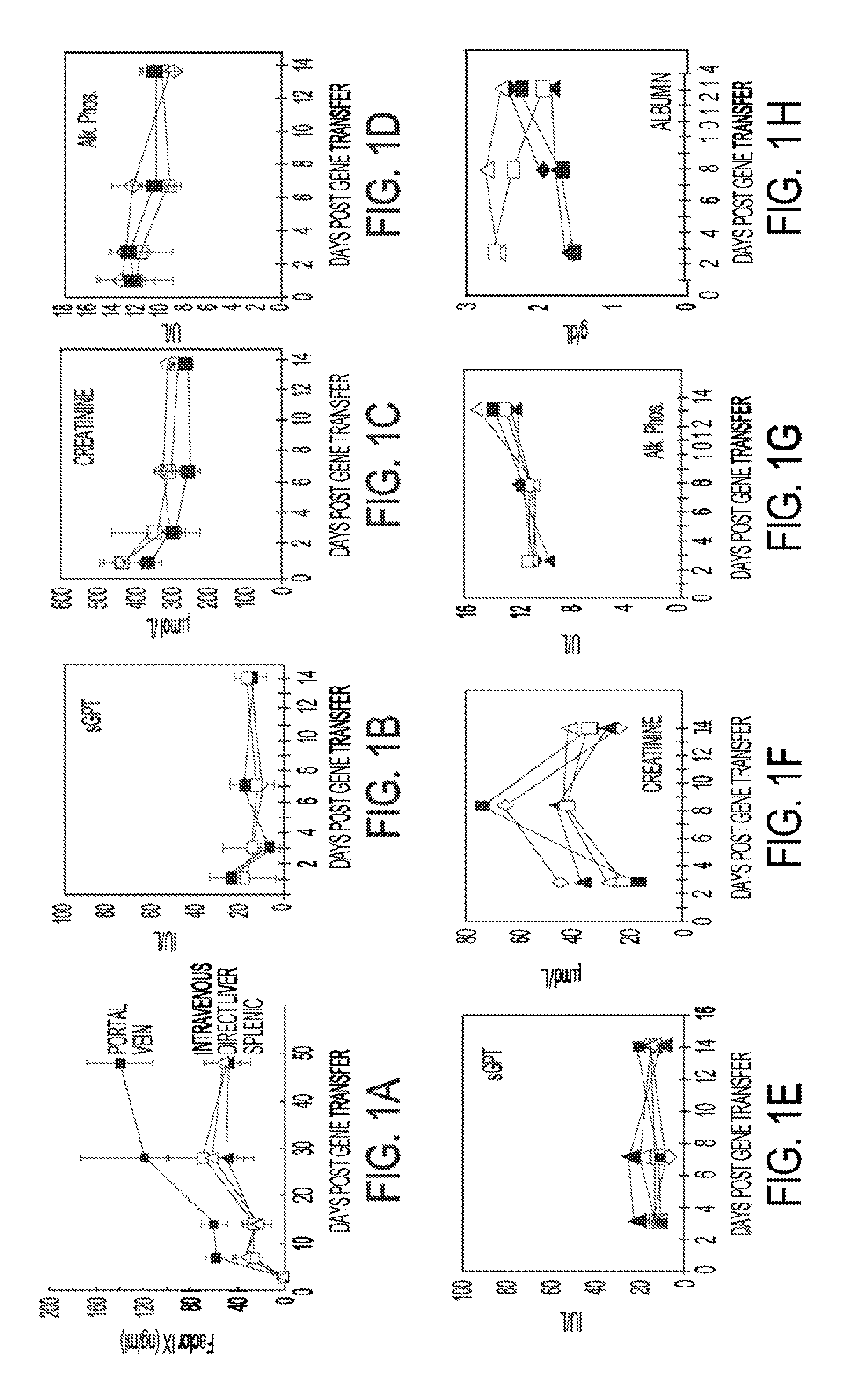Lentiviral vectors featuring liver specific transcriptional enhancer and methods of using same
a technology of transcriptional enhancer and lentiviral vector, which is applied in the field of gene therapy, can solve the problems of high liver toxicity and high mortality, and achieve the effect of stable cell genetic modification
- Summary
- Abstract
- Description
- Claims
- Application Information
AI Technical Summary
Benefits of technology
Problems solved by technology
Method used
Image
Examples
example 1
Production of Human Factor IX without Toxicity in Mice after Vascular Delivery of a Lentiviral Vector
[0081]Replication deficient lentiviral vectors have been shown to enable the stable genetic modification of multiple cell types in vivo. This example demonstrates that vascular and hepatic delivery of therapeutic doses of a 3rd generation HIV derived lentiviral vector encoding human Factor IX (LV-hFIX) produce therapeutic serum levels of hFIX protein with no vector mediated local or systemic toxicity of adult mice. Vascular delivery of the lentiviral vector resulted in the preferential transduction of the liver and spleen without any concomitant virus-mediated cytopathology. Cell proliferation was not required for hepatocyte transduction with either a LV encoding hFIX or a LV encoding GFP. Portal vein administration produced the highest serum levels of hFIX and demonstrated proportionally higher levels of gene transfer to the liver with up to 35% of cells, hepatocytes, endothelial ce...
example 2
Enhancer1 Augments Expression of Factor VIII in Hepatocytes
[0138]Enhancers are composed of smaller elements that can be combined alone or with other elements to produce stronger transcription and varied tissue-specificity. This example describes the creation of a novel liver (hepatocyte) specific synthetic transcriptional enhancer that is capable of increasing expression in a tissue specific manner from a number of promoter elements, and hence represents a more classical “enhancer” that functions with multiple promoters.
[0139]The novel transcriptional enhancer was created by synthesizing oligonucleotide binding sites for six liver (hepatocyte) transcription factors and ligating (inking) these sites together in stoichiometric amounts. The six transcription factors, which are described in the literature and known to those skilled in the art, are as follows:
[0140]
DBP5′-ATTATGTAAG-3′;(SEQ ID NO: 4)EBP5′-ATTGCGGCAAT-3′;(SEQ ID NO: 5)HNF15′-AGGTTAATAATTACCAG-3′;(SEQ ID NO: 6)HNF35′-GAYTAT...
example 3
Enhancer1 Combined with mTTR Promoter Provides High-Level Expression of Factor VIII in Hepatocytes
[0145]This example, like Example 2 above, addresses the problem of obtaining adequate gene expression (therapeutic levels) for gene therapy based applications. It also addresses immunological concerns by directing expression in a tissue specific manner. Previous constructs used ubiquitous promoters that theoretically would allow gene expression in antigen presenting cells thereby initiating or accelerating immunological activity against the therapeutic molecule.
[0146]This example describes a novel combination of Enhancer1 with a hepatocyte specific promoter derived from the mouse transthyretin (mTTR) gene. A preferred use of this combination involves driving expression of the human Factor VIII gene for gene therapy applications using a lentivirus-based vector. The novel enhancer element is combined with a promoter element (mTTR) that already contains its own transcriptional enhancer. Th...
PUM
| Property | Measurement | Unit |
|---|---|---|
| body weight | aaaaa | aaaaa |
| time | aaaaa | aaaaa |
| time | aaaaa | aaaaa |
Abstract
Description
Claims
Application Information
 Login to View More
Login to View More - R&D
- Intellectual Property
- Life Sciences
- Materials
- Tech Scout
- Unparalleled Data Quality
- Higher Quality Content
- 60% Fewer Hallucinations
Browse by: Latest US Patents, China's latest patents, Technical Efficacy Thesaurus, Application Domain, Technology Topic, Popular Technical Reports.
© 2025 PatSnap. All rights reserved.Legal|Privacy policy|Modern Slavery Act Transparency Statement|Sitemap|About US| Contact US: help@patsnap.com



